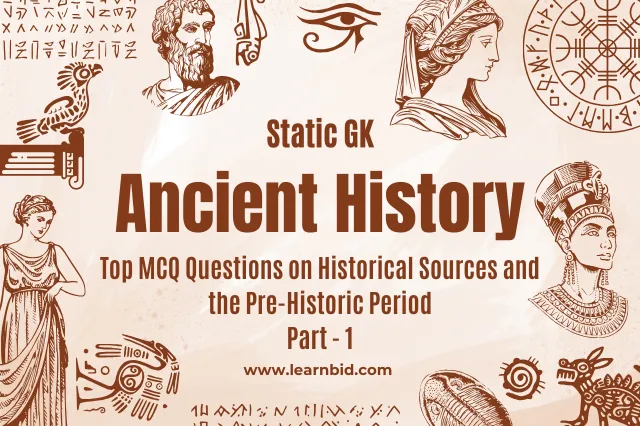Answer: A) The study of inscriptions
Ancient History: Top MCQ on Historical Sources and Pre-Historic Period

1. What does Epigraphy refer to?
- The study of inscriptions
- A graphical map
- The detection of epics
- The study of epics
Show Answer
2. The Rigveda can be best described as a:
- Collection of hymns
- Collection of stories
- Collection of words
- Text of war
Show Answer
Answer: A) Collection of hymns
3. In which ancient text is the name ‘Bharatvarsha’ mentioned?
- Ashtadhyayi
- Arthashastra
- Aryabhatiya
- Acharanga Sutra
Show Answer
Answer: A) Ashtadhyayi
4. Which Veda is considered the oldest?
- Yajurveda
- Rigveda
- Samaveda
- Atharvaveda
Show Answer
Answer: B) Rigveda
5. The term ‘Aryavarta’ for India is derived from the inhabitants known as:
- Bharat
- Dravida
- Aryan
- Dushyant
Show Answer
Answer: C) Aryan
6. An early Sanskrit inscription can be found at:
- Uttar Merur
- Gwalior
- Aihole
- Junagarh Rock
Show Answer
Answer: D) Junagarh Rock
7. Who first deciphered Ashokan edicts?
- Bunler
- Robert Sebal
- James Prinsep
- Cordriguttan
Show Answer
Answer: C) James Prinsep
8. Which of the following is true about the naming of India?
I. The name India is derived from the Rigvedic tribe ‘Bharat.’
II. India is considered part of Jambu Dweepa.
- Only I
- Only II
- Both I and II
- Neither I nor II
Show Answer
Answer: C) Both I and II
9. What type of inscription is the Lumbini pillar inscription of Ashoka?
- Royal commemorative inscription
- Donative inscription
- Dedicative inscription
- Votive inscription
Show Answer
Answer: A) Royal commemorative inscription
10. Who is known as the ‘Father of Indian Archaeology’?
- Alexander Cunningham
- John Marshall
- Mortimer Wheeler
- James Prinsep
Show Answer
Answer: A) Alexander Cunningham
11. Who decoded the Brahmi and Kharosthi scripts?
- Piyadassi
- Colin Mackenzie
- Alexander Cunningham
- James Prinsep
Show Answer
Answer: D) James Prinsep
12. The Kharosthi script was mainly used in which region?
- Northwestern region (modern-day Pakistan)
- Eastern India
- Southern India
- Central India
Show Answer
Answer: A) Northwestern region (modern-day Pakistan)
13. Which of the following is true about ancient inscriptions?
- They are free from interpolation.
- Found at many locations.
- Easy to analyze.
- All of the above.
Show Answer
Answer: D) All of the above
14. The Brahmi script was first deciphered using inscriptions found on:
- Stone tablets
- Seals
- Pillars
- Coins
Show Answer
Answer: A) Stone tablets
15. Which of these falls under commercial inscriptions?
- Junagarh
- Aihole
- Gwalior
- Seal of Indus Valley
Show Answer
Answer: D) Seal of Indus Valley
16. Which ancient Indian script was written from right to left?
- Brahmi
- Nandnagari
- Sharada
- Kharosthi
Show Answer
Answer: D) Kharosthi
17. Where was the Pre-Ashokan Brahmi script discovered?
- Nagarjunakonda
- Anuradhapura
- Brahmagiri
- Maski
Show Answer
Answer: B) Anuradhapura
18. Consider these statements about writing scripts:
I. Kharosthi is written from left to right.
II. Devanagari is written from left to right.
- Only I
- Only II
- Both I and II
- Neither I nor II
Show Answer
Answer: B) Only II
19. What is the study of coins called?
- Epigraphy
- Numismatics
- Coinology
- Ethnography
Show Answer
Answer: B) Numismatics
20. In which Vedic text is the term ‘Varna’ mentioned for the first time?
- Rigveda
- Atharvaveda
- Samaveda
- Yajurveda
Show Answer
Answer: A) Rigveda

